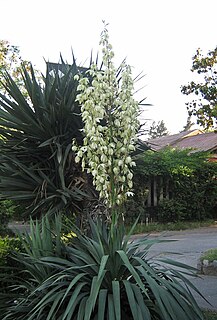
Yucca gloriosa is a species of flowering plant in the family Asparagaceae, native to the southeastern United States. Growing to 2.5 m (8 ft), it is an evergreen shrub. It is widely cultivated as an ornamental for its architectural qualities, and has reportedly become established in warmer climates in the wild in various parts of the world.

Yucca aloifolia is the type species for the genus Yucca. Common names include aloe yucca, dagger plant, and Spanish bayonet. It grows in sandy soils, especially on sand dunes along the coast.

Caryota mitis, known as the clustering fishtail palm or fishtail palm, is a species of palm native to Tropical Asia from India to Java to southern China, now sparingly naturalized in southern Florida and in parts of Africa and Latin America. The species was originally described from Vietnam in 1790. In Florida, it grows in hummocks and in disturbed wooded areas.
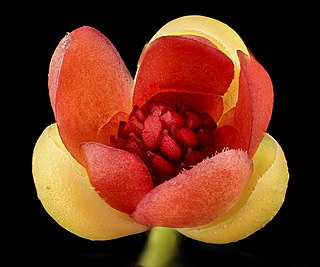
Schisandra glabra, the bay star-vine, is the only American species of this primarily Asian genus. It is native to the southeastern United States and northern Mexico. It grows in Louisiana, eastern Arkansas, southwestern Tennessee, Mississippi, Alabama, northwestern Florida, and Georgia, with isolated populations in Kentucky, South Carolina, North Carolina, and Hidalgo. Despite its wide range, it is considered a vulnerable species. Few populations are secure due to competition from invasive species and habitat loss.

Celtis ehrenbergiana, called the desert hackberry or spiny hackberry, is a plant species that has long been called C. pallida by many authors, including in the "Flora of North America" database. It is native to Arizona, Florida, New Mexico and Texas, and to Latin America as far south as central Argentina. It grows in dry locations such as deserts, brushlands, canyons, mesas and grasslands.
Parietaria praetermissa, the clustered pellitory, is a plant species native to the coastal plains of the southeastern United States, i.e., Georgia, Florida, Louisiana, North Carolina and South Carolina. It grows in hammocks, waste places, calcareous outcrops, etc., at elevations of 10 m.

Ardisia escallonioides, the Island marlberry, is a plant species native to the West Indies and neighboring areas. It has been reported from Barbados, Bermuda, the Dominican Republic, Cuba, Mexico, Belize, Guatemala and Florida.

Styrax americanus, the American snowbell or mock-orange, is a plant species native to the southeastern United States and the Ohio Valley. It has been reported from Texas and Florida to Virginia and Missouri. It generally grows in swamps and on floodplains and in other wet locations.

Smilax auriculata, is a North American plant species native to the Bahamas, the Turks & Caicos Islands, and the southeastern United States. Common names include earleaf greenbrier and wild-bamboo, despite the fact that it is not closely related to bamboo. It is reported from Florida, Georgia, North and South Carolina, Alabama, Mississippi, and Louisiana. It grows on coastal sand dunes and in sun-lit locations in sandy woodlands at elevations of less than 100 m.

Vanilla phaeantha, common name leafy vanilla or oblong-leaved vanilla, is a plant species known to occur in the wild only on the islands of Trinidad and Cuba, and also in Collier County, Florida. It occurs in cypress swamps and hammocks at elevations of less than 20 m.

Bletia purpurea, common name pine-pink or sharp-petaled bletia, is a species of orchid widespread across much of Latin America and the West Indies, and also found in Florida. They are terrestrial in swamps or sometimes found growing on logs or stumps above the high tide mark.
Calycocarpum (cupseed) is a monotypic genus of plants in the family Menispermaceae. The only species currently accepted is Calycocarpum lyonii endemic to the southeastern United States.
Parietaria floridana, common name Florida pellitory, is a plant species native to the southeastern United States, the West Indies, and much of Latin America. In the US, the heart of its range extends from Florida, to Georgia and North and South Carolina, with isolated populations reported in Mississippi, Louisiana, Texas, New Hampshire, Kentucky and Delaware. Some populations in California have in the past been referred to as P. floridana but are now regarded as a separate species, P. hespera.
Polygonum delopyrum, the fringed jointweed or hairy jointweed, is a plant species endemic to Florida. It is found in pinelands and sandy pine barrens at elevations less than 50 m, in central and southern parts of the state.

Chaptalia tomentosa, common name pineland daisy, is a plant species native to the southeastern United States. It has been reported from southern Alabama, Florida, southern Georgia, Louisiana, eastern Texas, southern Mississippi, eastern North Carolina and South Carolina. Some publications report the species from the West Indies as well, but this is based on the assumption that C. azurensis is a synonym of C. tomentosa.
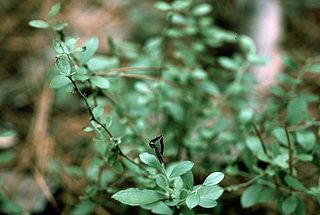
Vaccinium tenellum, the small black blueberry is a plant species native to the southeastern United States from southeastern Mississippi to northern Florida to southern Virginia. It grows in forests and in shrubby areas at elevations up to 200 m.
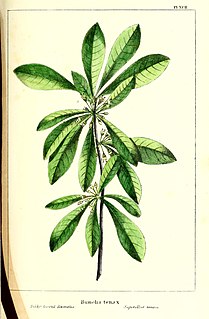
Sideroxylon tenax, called the tough bully, is a plant species native to Florida, Georgia, South Carolina and the southernmost part of North Carolina. It grows on dry, sandy soil in pine forests, pine-oak woodlands, and hummocks at elevations less than 100 m.
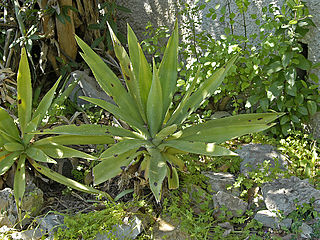
Agave decipiens, common names False Sisal or Florida agave, is a plant species endemic to coastal Florida though cultivated as an ornamental in other regions. The species is reported naturalized in Spain, India, Pakistan, and South Africa.
Chromolaena frustrata called Cape Sable false thoroughwort, or Cape Sable thoroughwort, is a rare North American species of flowering shrub in the sunflower family. It is found only in southern Florida, on the Florida Keys, inside Everglades National Park, and other nearby low-lying areas. It grows on coastal rock outcrops, the edges of hammocks, and other undisturbed sites at elevations less than 10 meters above sea level.
Koanophyllon villosum, the Florida Keys thoroughwort, or abre camino, is a species of flowering plant in the sunflower family. It grows in southern Florida, Cuba, the Bahamas, Hispaniola, Jamaica, and the Islas de la Bahía.













